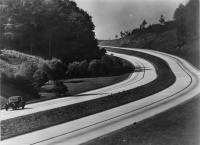Car
From The Art and Popular Culture Encyclopedia
| Revision as of 15:45, 6 March 2020 Jahsonic (Talk | contribs) ← Previous diff |
Current revision Jahsonic (Talk | contribs) |
||
| Line 1: | Line 1: | ||
| + | [[Image:Autobahn logo.png|left|thumb|200px|[[Autobahn]] logo]] | ||
| {| class="toccolours" style="float: left; margin-left: 1em; margin-right: 2em; font-size: 85%; background:#c6dbf7; color:black; width:30em; max-width: 40%;" cellspacing="5" | {| class="toccolours" style="float: left; margin-left: 1em; margin-right: 2em; font-size: 85%; background:#c6dbf7; color:black; width:30em; max-width: 40%;" cellspacing="5" | ||
| | style="text-align: left;" | | | style="text-align: left;" | | ||
| Line 5: | Line 6: | ||
| {{Template}} | {{Template}} | ||
| An '''automobile''', '''autocar''', '''motor car''' or '''car''' is a wheeled [[motor vehicle]] used for [[transportation|transporting]] [[passenger]]s, which also carries its own engine or motor. Most definitions of the term specify that automobiles are designed to run primarily on roads, to have seating for one to eight people, to typically have four wheels, and to be constructed principally for the transport of people rather than goods. | An '''automobile''', '''autocar''', '''motor car''' or '''car''' is a wheeled [[motor vehicle]] used for [[transportation|transporting]] [[passenger]]s, which also carries its own engine or motor. Most definitions of the term specify that automobiles are designed to run primarily on roads, to have seating for one to eight people, to typically have four wheels, and to be constructed principally for the transport of people rather than goods. | ||
| + | ==Etymology== | ||
| + | Inherited from Middle English ''carre'', borrowed from Anglo-Norman ''carre'', from Old Northern French (compare Old French ''char''), from Latin ''carra'', neuter plural of ''carrum'' (“four-wheeled baggage wagon”), from Gaulish ''*karros'', from Proto-Celtic ''*karros'' (“wagon”). Doublet of [[horse]]. | ||
| + | |||
| + | ==Car art== | ||
| + | :''[[Art car]]'' | ||
| + | * [[Kustom Kar Kommandos]] (1965) by Kenneth Anger | ||
| + | *''[[Concrete Traffic]]'' (1970) | ||
| + | *''[[Cadillac Ranch]]'' (1974) | ||
| + | |||
| ==See also== | ==See also== | ||
| + | *[[Art car]] | ||
| *[[Automotive design]] | *[[Automotive design]] | ||
| + | *[[Automobile graveyard]] | ||
| *[[Car crash]] | *[[Car crash]] | ||
| *[[Concept car]] | *[[Concept car]] | ||
| *[[Classic car]] | *[[Classic car]] | ||
| *[[Car crusher]] | *[[Car crusher]] | ||
| - | *[[Vintage car]] | ||
| - | *[[Car Styling]] | ||
| *[[Car culture]] | *[[Car culture]] | ||
| *[[Car chase]] | *[[Car chase]] | ||
| *[[Car-wreck]] | *[[Car-wreck]] | ||
| + | *[[Hot rod]] | ||
| + | *[[Road movie]] | ||
| *[[Triumphal car]] | *[[Triumphal car]] | ||
| + | *[[Vintage car]] | ||
| {{GFDL}} | {{GFDL}} | ||
Current revision

|
"It is estimated that motor vehicle collisions caused the deaths of around 60 million people during the 20th century, around the same as the number of World War II casualties but considerably less than the 200 million dead in what is known as the hemoclysm (Stalin, Hitler, and Mao)." --Sholem Stein |
|
Related e |
|
Featured: |
An automobile, autocar, motor car or car is a wheeled motor vehicle used for transporting passengers, which also carries its own engine or motor. Most definitions of the term specify that automobiles are designed to run primarily on roads, to have seating for one to eight people, to typically have four wheels, and to be constructed principally for the transport of people rather than goods.
Etymology
Inherited from Middle English carre, borrowed from Anglo-Norman carre, from Old Northern French (compare Old French char), from Latin carra, neuter plural of carrum (“four-wheeled baggage wagon”), from Gaulish *karros, from Proto-Celtic *karros (“wagon”). Doublet of horse.
Car art
- Kustom Kar Kommandos (1965) by Kenneth Anger
- Concrete Traffic (1970)
- Cadillac Ranch (1974)
See also
- Art car
- Automotive design
- Automobile graveyard
- Car crash
- Concept car
- Classic car
- Car crusher
- Car culture
- Car chase
- Car-wreck
- Hot rod
- Road movie
- Triumphal car
- Vintage car


